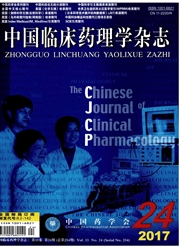

 中文摘要:
中文摘要:
目的建立一种阿尔茨海默病(AD)样神经炎症模型。方法 25只雄性SD大鼠随机分为对照组(n=10)及模型组(n=15)。模型组大鼠每周1次腹腔注射脂多糖(LPS)0.5 mg/kg,连续13周,对照组注射等体积溶媒。13周后,Morris水迷宫检测大鼠的学习记忆能力。处死大鼠,HE染色、透射电镜观察大鼠海马神经元形态,Western blot法检测海马淀粉样前体蛋白(APP)、β-分泌酶表达及淀粉样蛋白(Aβ)含量,相关炎症因子(TNF-α、IL-1β、COX-2)蛋白表达,以及调控信号IκB-α含量及p-NF-κB p65水平。结果模型组大鼠平均逃避潜伏期较对照组明显延长,海马组织结构破坏,线粒体肿胀、突触结构模糊不清。模型组大鼠海马的APP、β-分泌酶与TNF-α、IL-1β、COX-2蛋白表达,Aβ含量及调控信号p-NF-κB p65水平均较对照组明显增加,IκB-α含量较对照组明显降低。结论反复腹腔注射脂多糖可诱导大鼠AD样神经炎症,该模型操作简单、稳定,可用于大鼠AD样神经炎症的发生机制研究及抗AD药物评价。
 英文摘要:
英文摘要:
Objective To establish a model with Alzheimer’s disease(AD)-like neuroinflammation.Methods25 male Sprague-Dawley rats were randomly divided into control(n = 10) and model(n = 15).Rats in model were administrated with lipopolysaccharide(LPS) at the dose of 0.5 mg/kg by intraperitoneal injection(i.p.)once a week continuously for 13 weeks,while control were administrated with volume-matched solvent by i.p.instead.After 13 weeks,learning and memory functions were evaluated using Morris water maze in rats.After rats were sacrificed,neuronal morphology in CA1 region of hippocampus were observed by Hematoxylin and Eosin staining and transmission electron microscopy(TEM),respectively.Amyloid precusor protein(APP),β-secretase protein expressions and β-amyloid(Aβ) content,protein expressions of inflammatory factors including tumor necrosis factor(TNF-α),interleukin-1β(IL-1β) and cydooxygenase-2(COX-2),as well as IκB-α content and p-NF-κB p65 level in hippocampus were analyzed by Western blot,respectively.Results Mean escape latency of rats in model was significantly longer than that of control,and hippocampal structure was damaged and unclear severely,mitochondrial was swelled and synaptic structure was blurred in the model group.Protein expressions of APP,β-secretase,TNF-α,IL-1β and COX-2,Aβ content and p-NF-κB p65level in hippocampus of rats in model were significantly increased than those in control,while IκB-α content in hippocampus of rats in model was significantly decreased than that in control.Conclusion Repetitious intrapefitoneal injection of LPS may induce AD-like neuroinflammation in rats.The model is steady and easy to establish,and it may be applied to study the developmental mechanisms of AD-like neuroinflammation and evaluate anti-AD drugs in rats.
 同期刊论文项目
同期刊论文项目
 同项目期刊论文
同项目期刊论文
 期刊信息
期刊信息
